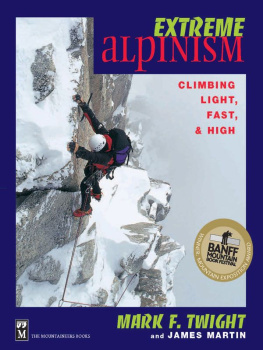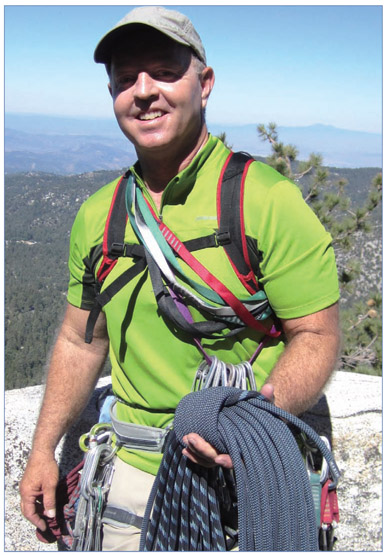About the Authors
John Long is the author of twenty-five books, with over one million copies in print. He is the principal author of the How to Rock Climb series. His short-form literary stories have been widely anthologized and translated into many languages. John won the 2006 Literary Award for excellence in alpine literature from the American Alpine Club.
PHOTO BY ROBERT MIRAMONTES;
JOHN LONG COLLECTION
Bob Gaines is an AMGA Certified Rock Guide who has been teaching rock climbing since 1983. He is the owner/director of Vertical Adventures Climbing School, based at Joshua Tree National Park, California, where he has taught clients ranging from Boy Scouts to Navy Seals. Bob has also worked extensively as a climbing stunt coordinator on over 40 television commercials. He was the chief safety officer for the movie Cliffhanger and doubled for Captain Kirk when Kirk free soloed El Capitan in Star Trek V. Bob is also the author of Best Climbs Joshua Tree National Park (Globe Pequot Press, 2012), Best Climbs Tahquitz and Suicide Rocks (Globe Pequot Press, 2013), and Toproping (Globe Pequot Press, 2012).
Acknowledgments
S pecial thanks to Jim Ewing, research and development manager at Sterling Ropes, who conducted all the drop tests; Mark Chatwin, of Chatwin Guides, and Kolin Powick, quality assurance manager at Black Diamond, who critiqued versions of the text; Tom Cecil, of Seneca Rocks Mountain Guides, who exhaustively field-tested rigging systems; Dr. Richard Goldstone and Craig Connally, who provided studied opinions and hard figures about fall forces and anchor systems; Dr. Lawrence Hamilton and Dr. Callie Rennison, who fashioned the statistical analysis for Jims testing; editor and project expediter John Burbidge, who kept this monster on course from start to finish; and my coauthor, Bob Gaines, director of Vertical Adventures, whoamong many other dutiesprovided most of the photos.
Appendix
Gear Manufacturers and Sources
Black Diamond Equipment, Ltd.
2084 East 3900 South
Salt Lake City, UT 84124
(801) 278-5533
www.bdel.com
Blue Water
209 Loworn Rd.
Carrollton, GA 30117
(770) 834-7515
www.bluewaterropes.com
Mammut Sports Group
(formerly Climb High)
135 Northside Dr.
Shelburne, VT 05482
(802) 985-5056
www.mammutusa.com
Metolius Climbing
63189 Nels Anderson Rd.
Bend, OR 97701
(541) 382-7585
www.metoliusclimbing.com
Pigeon Mountain Industries (PMI)
P.O. Box 803
LaFayette, GA 30728
(800) 282-7673
www.pmirope.com
SMC
6930 Salashan Pkwy.
Ferndale, WA 98248
(360) 366-5532
www.smcgear.net
Sterling Rope
26 Morin St.
Biddeford, ME 04005-4413
(207) 282-2550
www.sterlingrope.com
Wild Country
Meverill Road
Buxton, Derbyshire, England
SK17 8PY
44 (0) 1298-871-010
www.wildcountry.co.uk
Wild Country distributed in the United States by:
Excalibur
P.O. Box 1007
Sandy, UT 84091
(801) 942-8471
xcalibur@mindspring.com
Yates Gear, Inc.
2608 Hartnell Ave. #6
Redding, CA 96002
(530) 222-4606
www.yatesgear.com
Essential Reading
Each years climbing accidents are compiled and published in Accidents in North American Mountaineering, available at climbing shops nationwide.
Black Diamond comparative testing of high-tensile cord: www.xmission.com/~tmoyer/testing.
American Safe Climbing Association (ASCA) web-site, www.safeclimbing.org. Good resource for those who want to place bolts.
Supplemental Instruction
The American Mountain Guides Association (AMGA) is an excellent source of qualified instructors and guides. They can be reached at P.O. Box 1739, Boulder, CO 80306; (303) 271-0984.
Vertical Adventures, run by coauthor Bob Gaines, offers instructional and guiding services in Joshua Tree and Idylwild, California. (800) 514-8785; www.verticaladventures.com; e-mail BGvertical@aol.com.
PHOTO BY ANDREW BURR
CHAPTER ONE
Natural Anchors
N atural anchors consist of anything that the environment providestrees, blocks, horns of rock, etc. Many times a natural anchor is stronger than anything you could arrange with store-bought gear. Like any other anchor, there are numerous considerations that affect the strength of a natural anchor.
Of the many advantages of using sound natural anchors, three stand out. First, they are typically easy and fast to arrange. You might simply loop or girth a tree or a block (or whatever) with runners. Second, a slung natural anchor is often bombproof no matter the loading direction (multidirectional). Third, natural anchors are usually the least environmentally disruptive means of protection.
Trees
Anchoring to a 50-foot oak that casts a shadow like a thundercloud is pretty straightforward work. Judgment enters the game once the trees become smaller and are located on top of the cliff, on ledges, and on shelves. Ive seen some analyses of which trees are best suited for use as anchors; some of these go so far as to study the individual grain of the tree. But most of thisand everything else for that matterbasically boils down to common sense. Still there are several considerations worth noting.
Some climbers think anything with bark on it is bomber, and the infamous Tobin Sorrenson was one of them. It was at Granite Mountainnot the gem in Prescott, Arizona, but a scrappy little cliff outside Amboy, California, that has for years been closed to climbing. (An old rummy with a 12-gauge full of rock salt stands guard, in case youre wondering.) Tobin was leading up one of those greasy, teetering slabs that look like you could make good time up it in flip flops, when in fact your only hope is to keep your $150 boots bicycling like Wile E. Coyote. When I clawed up to Tobins belay and saw the anchor, I lost my mind.
What the hell is that, Tobin?!
Its a tree....
Id shot pool with a bigger tree than this one.
Natural Anchors
- Anything the environment providestrees, blocks, horns of rock, etc.
- Often more secure than gear-built anchors
- Typically easy and fast to arrange
- Multidirectional (can be loaded from any direction)
- By and large environmentally friendly
Thats not a tree, its a twig. A dead twig. And it was sticking out of a clump of orange moss on an angled, shaly little foothold stance. I reached over and yanked the sad thing out with about ten pounds of heft.
Jesus! You trying to kill us or something?! Tobin cried.
The point is that what the tree is rooted in is probably more crucial than the breadth of the tree itself. Good-size trees have pulled out; the big one atop the first pitch of a route called Catchy, at the Cookie Cliff in Yosemite, being a case in point. While there is likely no single and reliable way for a climber to know or test how well a tree is rooted, were left to do a thorough inspection, including shaking the tree to check for movement. While some books have suggested various forestry strategies to establish the holding power of trees, no two trees are the same. Ive personally hooked a tractor to a tree no thicker than my arm and only managed to break a chain in trying to yard out the implacable pine. Ive also seen trees big around as a pickle barrel come totally uprooted after a thunder shower. Nevertheless we need a few provisional guidelines to help guide our choices.











